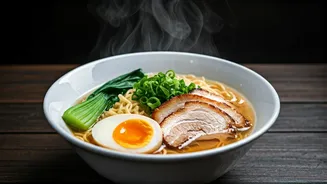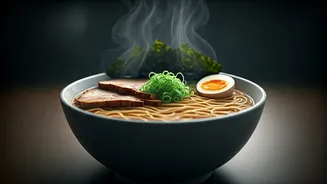Ramen's Global Appeal
Ramen, a beloved noodle soup, has transcended its Japanese origins to become a global phenomenon. Its appeal lies in its comforting warmth, the symphony
of flavors, and its customizable nature. The base of ramen typically includes wheat noodles served in a flavorful broth, accompanied by a variety of toppings. This versatility allows for endless variations, from rich and savory to light and refreshing, catering to diverse palates. Whether it's a quick lunch or a late-night craving, ramen's accessibility and satisfying nature make it a universally enjoyed dish, constantly evolving as chefs and diners experiment with new ingredients and techniques. Its simplicity, combined with the complex balance of flavors, ensures its enduring popularity across cultures.
Tokyo Ramen Varieties
Tokyo's ramen scene is a treasure trove of regional styles. Tonkotsu ramen, characterized by its rich, creamy pork bone broth, is a staple, with each restaurant crafting its unique version. Shoyu ramen, a soy sauce-based broth, offers a lighter, more delicate flavor, often paired with chashu pork and marinated eggs. Miso ramen, using a fermented soybean paste, brings a deep umami flavor, often complemented by corn, butter, and other toppings. Tsukemen, where noodles are served separately for dipping in a concentrated broth, provides an interactive dining experience. Each style showcases Tokyo's culinary prowess, constantly evolving through innovation and dedication, making it a place for diverse ramen experiences.
Iconic Tokyo Eateries
Several ramen restaurants in Tokyo have gained legendary status. Ichiran is celebrated for its customizable ramen, allowing diners to tailor their experience. Fuunji is known for its exquisite tsukemen, featuring a rich, flavorful dipping broth and perfectly cooked noodles. Nakiryu, a Michelin-starred establishment, crafts exceptional dandan noodles and ramen. Ebisoba Ichigen is known for its prawn-flavored broth. T's Tantan offers delicious vegan ramen options, proving ramen's versatility. Visiting these restaurants is a must for any ramen enthusiast in Tokyo, as it helps discover the range of flavors and quality the city offers. They all demonstrate a dedication to craftsmanship and culinary excellence.
Ordering Like A Pro
Navigating a Tokyo ramen shop can be an adventure. Many establishments use a ticket system, where diners purchase their ramen tickets from a vending machine before being seated. Familiarizing yourself with the menu options is crucial. While English menus are becoming more common, learning basic Japanese phrases like "shoyu" (soy sauce), "tonkotsu" (pork bone), and "miso" (fermented soybean paste) can be helpful. Customize your ramen by adding toppings: extra chashu (braised pork belly), ajitsuke tamago (marinated egg), or menma (bamboo shoots). Don't be shy about slurping your noodles – it's a sign of appreciation! Enjoying the full flavor experience is essential to appreciating authentic Japanese ramen.
Beyond The Bowl
Ramen culture in Tokyo extends beyond the bowl. The ambiance of ramen shops, from the counter-only seating to the open kitchens, creates a unique experience. Many shops offer various side dishes, like gyoza (dumplings) and karaage (fried chicken), that complement the ramen. Explore the areas where ramen shops thrive, such as Shinjuku, Shibuya, and Ikebukuro, to immerse yourself in the local culinary scene. Consider the regional differences. For instance, some areas may specialize in specific ramen styles. Tokyo's ramen experience is a cultural dive, blending amazing flavors with a vibrant dining environment. Take time to try different shops and dishes to discover the true essence of ramen.
Ramen Etiquette Tips
When enjoying ramen in Tokyo, observe some basic etiquette. Slurping noodles loudly is considered a sign of enjoyment and appreciation for the chef's work, so do not hesitate. It's customary to finish the soup, though you do not have to. Be mindful of waiting times, as queues outside popular ramen shops are typical. Try not to linger long after finishing your meal, as many restaurants have limited seating. Showing respect and appreciation for the food and the establishment is valued. This adds to a positive dining experience. If you are sharing a table, be considerate of other diners by keeping your belongings out of the way. Understanding these nuances enriches the entire experience.


















